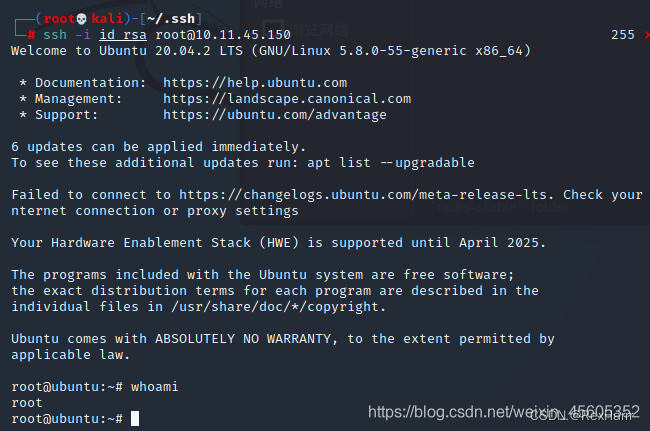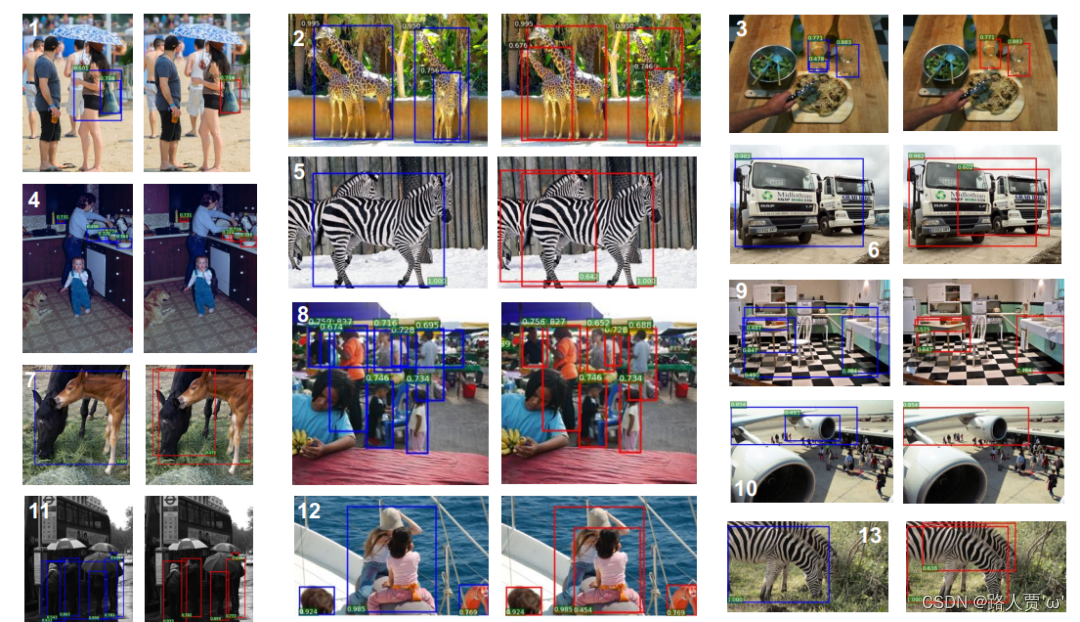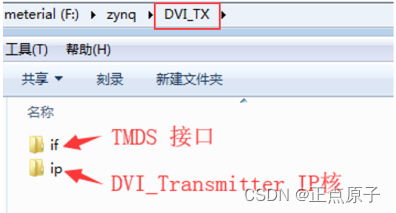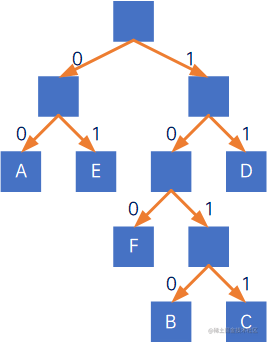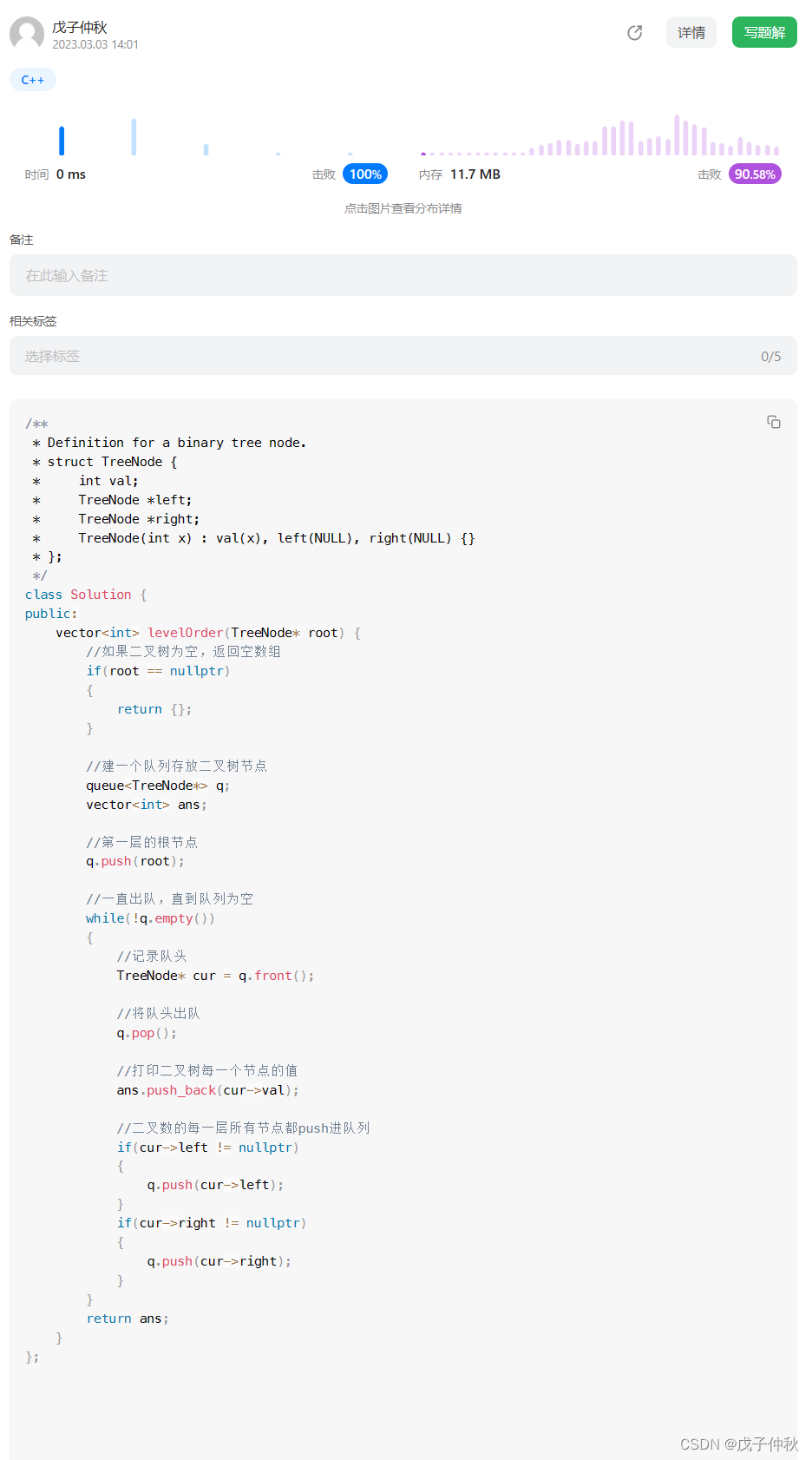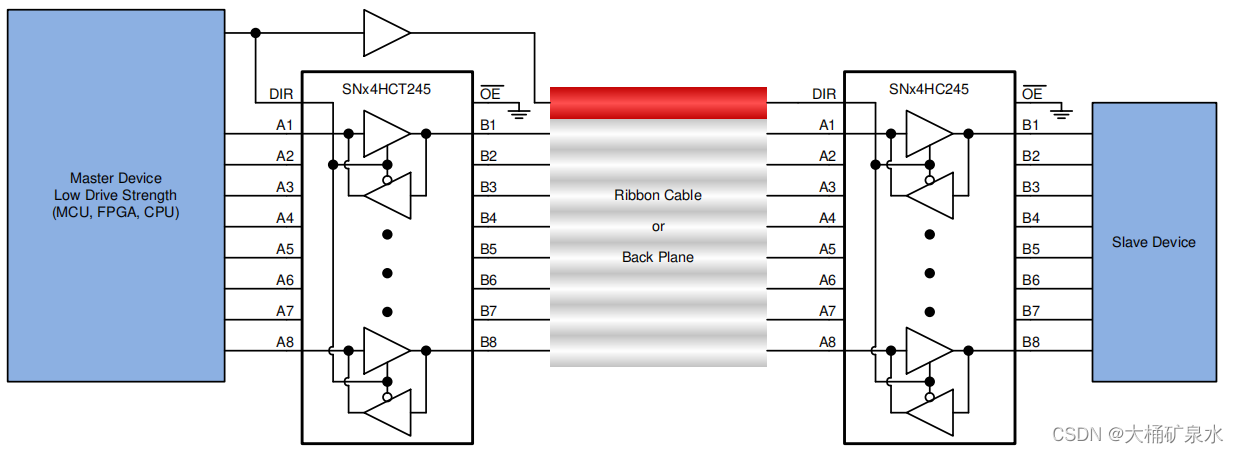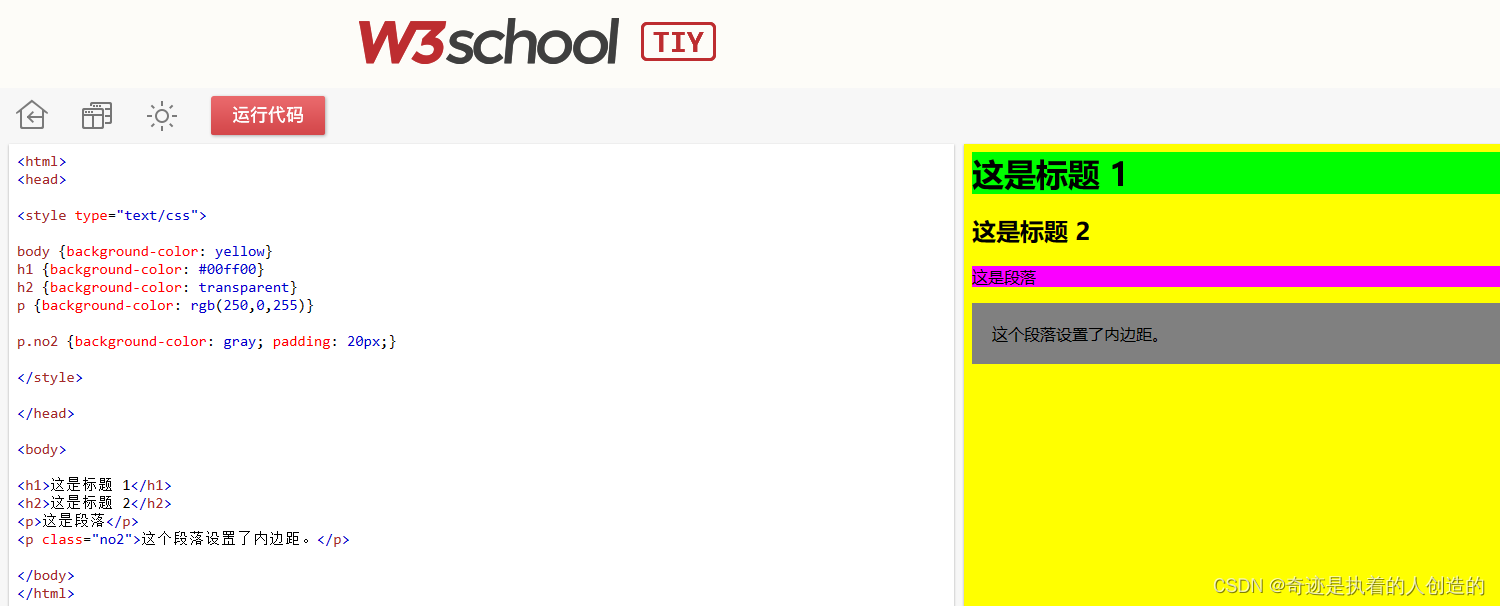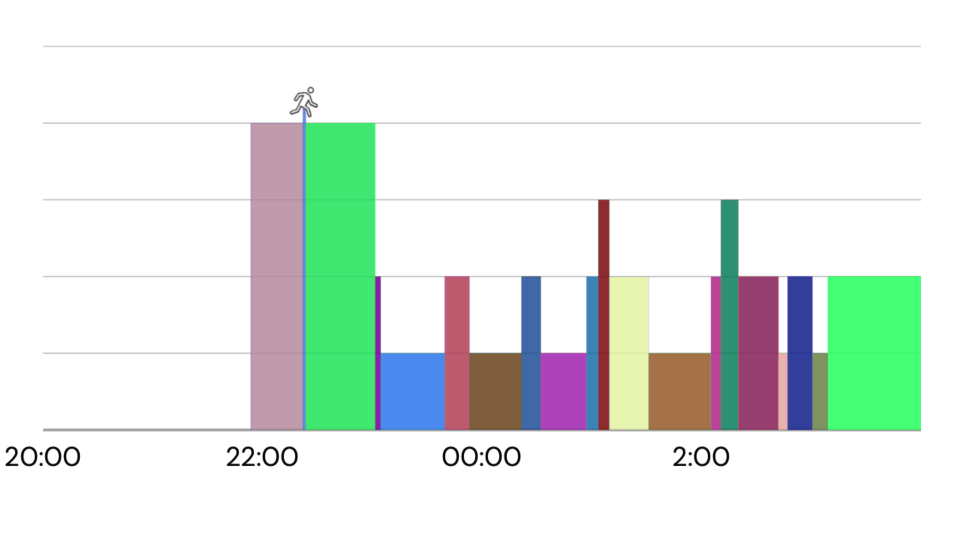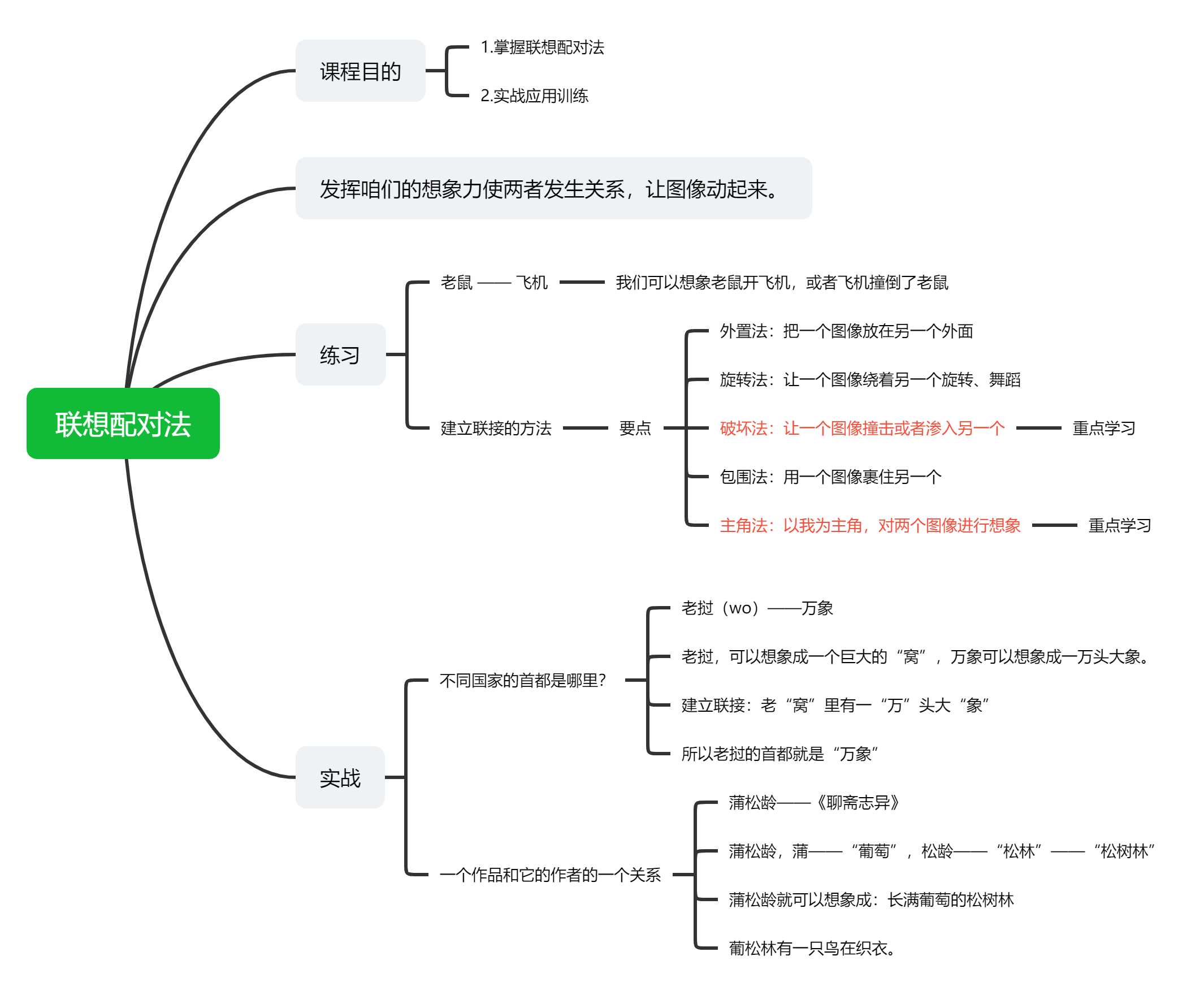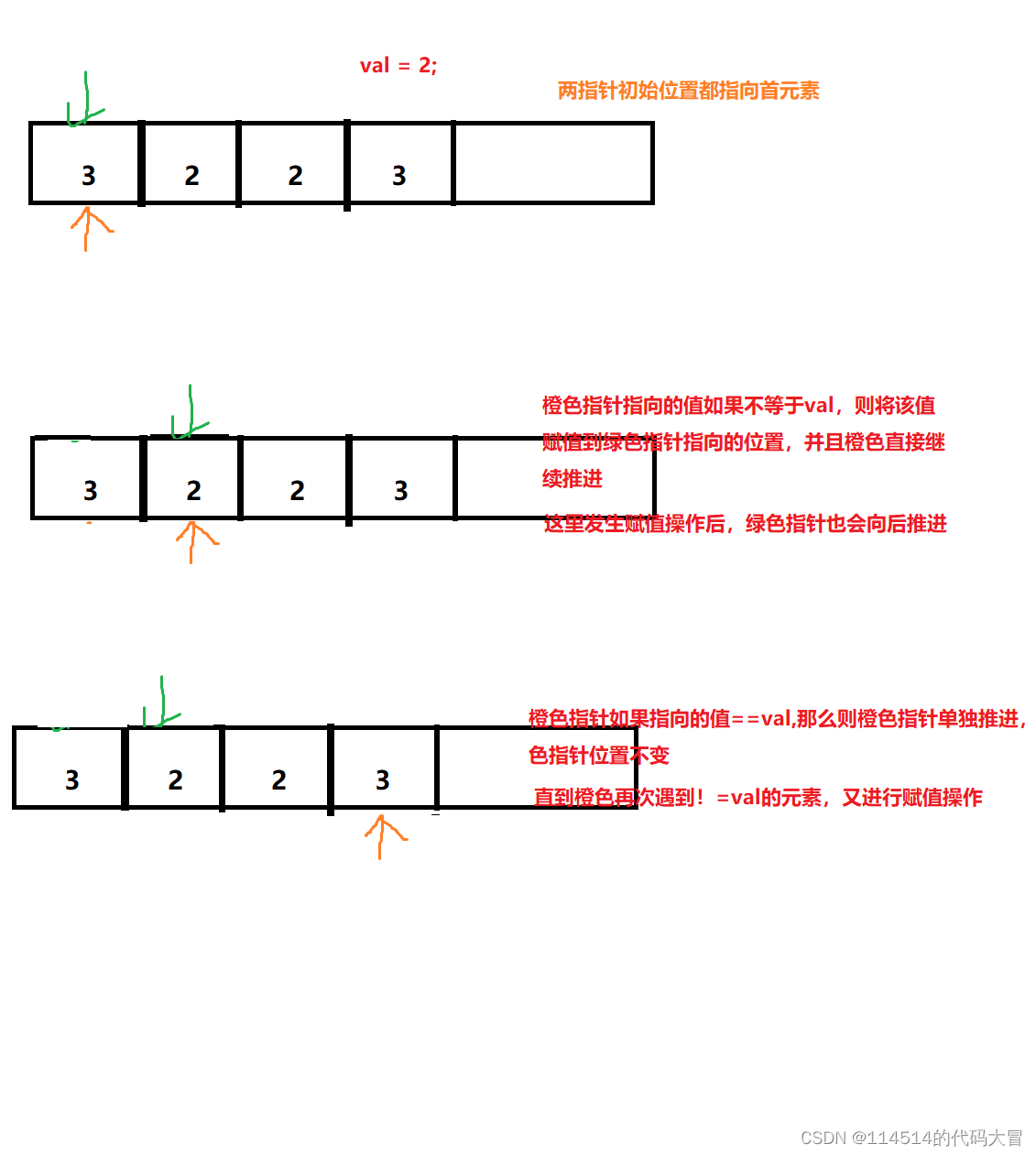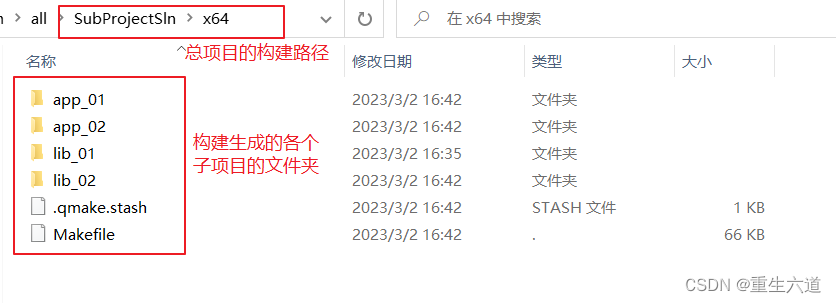目录
一、Linux I2C 驱动简介
1、I2C 总线驱动
2、I2C 设备驱动
1、 i2c_client 结构体
2、 i2c_driver 结构体
二、硬件分析
三、设备树编写
1、pinctrl_i2c1
2、在 i2c1 节点追加 ap3216c 子节点
3、验证
四、 代码编写
1、makefile
2、ap3216c.h
3、ap3216c.c
①、头文件
②、驱动出入口
③、 i2c驱动结构体
④、匹配函数
⑤、probe 函数
⑥、remove 函数
⑦、函数入口出口添加注册i2c_drive
⑧、读取AP3216C的N个寄存器
⑨、向AP3216C的N个寄存器写数据
⑩、读、写AP3216C一个寄存器
⑩①、读取AP3216C的数据
⑩②完善ap3216c_open、read函数
代码如下
4、ap3216c.c
一、Linux I2C 驱动简介
在IMX6ULL开发篇中"IIC实验"写了四个文件: bsp_i2c.c、bsp_i2c.h、 bsp_ap3216c.c 和 bsp_ap3216c.h。其中前两个是 I.MX6U 的 IIC 接口驱动,后两个文件是 AP3216C 这个 I2C 设备驱动文件。相当于有两部分驱动:
①、 I2C 主机驱动。
②、 I2C 设备驱动。
对于 I2C 主机驱动,一旦编写完成就不需要再做修改,其他的 I2C 设备直接调用主机驱动提供的 API 函数完成读写操作即可。这个正好符合 Linux 的驱动分离与分层的思想,因此 Linux内核也将 I2C 驱动分为两部分:
①、 I2C 总线驱动, I2C 总线驱动就是 SOC 的 I2C 控制器驱动,也叫做 I2C 适配器驱动。
②、 I2C 设备驱动, I2C 设备驱动就是针对具体的 I2C 设备而编写的驱动
1、I2C 总线驱动
在”platform驱动实验"的时候就说过, platform 是虚拟出来的一条总线,目的是为了实现总线、设备、驱动框架。对于 I2C 而言,不需要虚拟出一条总线,直接使用 I2C总线即可。 I2C 总线驱动重点是 I2C 适配器(也就是 SOC 的 I2C 接口控制器)驱动,Linux 内核将 SOC 的 I2C 适配器(控制器)抽象成 i2c_adapter, i2c_adapter 结构体定义在 include/linux/i2c.h 文件中,i2c_algorithm 类型的指针变量 algo,对于一个 I2C 适配器,肯定要对外提供读写 API 函数,设备驱动程序可以使用这些 API 函数来完成读写操作。 i2c_algorithm 就是 I2C 适配器与 IIC 设备进行通信的方法;i2c_algorithm 结构体定义在 include/linux/i2c.h 文件中,其中的master_xfer 就是 I2C 适配器的传输函数,可以通过此函数来完成与 IIC 设备之间的通信,smbus_xfer 是 SMBUS 总线的传输函数
一般 SOC 的 I2C 总线驱动都是由半导体厂商编写的,比如 I.MX6U 的 I2C 适配器驱动 NXP 已经编写好了,这个不需要用户去编写。因此 I2C 总线驱动对我们这些 SOC 使用者来说是被屏蔽掉的,我们只要专注于 I2C 设备驱动即可。
2、I2C 设备驱动
I2C 设备驱动重点关注两个数据结构: i2c_client 和 i2c_driver,i2c_client 就是描述设备信息的, i2c_driver 描述驱动内容,类似于 platform_driver
1、 i2c_client 结构体
i2c_client 结构体定义在 include/linux/i2c.h 文件中,内容如下:
struct i2c_client {
unsigned short flags; /* 标志 */
unsigned short addr; /* 芯片地址, 7 位,存在低 7 位*/
......
char name[I2C_NAME_SIZE]; /* 名字 */
struct i2c_adapter *adapter; /* 对应的 I2C 适配器 */
struct device dev; /* 设备结构体 */
int irq; /* 中断 */
struct list_head detected;
......
};一个设备对应一个 i2c_client,每检测到一个 I2C 设备就会给这个 I2C 设备分配一个i2c_client
2、 i2c_driver 结构体
i2c_driver 类似 platform_driver,i2c_driver 结构体定义在 include/linux/i2c.h 文件中,部分如下
struct i2c_driver {
.........
/* Standard driver model interfaces */
1 int (*probe)(struct i2c_client *, const struct i2c_device_id *);
......
2 struct device_driver driver;
3 const struct i2c_device_id *id_table;
..........
}第 1 行,当 I2C 设备和驱动匹配成功以后 probe 函数就会执行,和 platform 驱动一样。
第 2行, device_driver 驱动结构体,如果使用设备树的话,需要设置 device_driver
of_match_table 成员变量,也就是驱动的兼容(compatible)属性。
第3行, id_table 是传统的、未使用设备树的设备匹配 ID 表
重点工作就是构建 i2c_driver,构建完成以后需要向Linux 内核注册这个 i2c_driver
二、硬件分析
这部分在在IMX6ULL开发篇中"IIC实验"有详细介绍,下面就简单介绍
打开AP3216C原理图,这是一个IIC接口的器件,是一个环境光传感器


I2C1_SCL: 使用的是UART4_TXD这个IO;I2C1_SDA: 使用的是UART4_RXD这个IO
打开ap3216数据手册

地址为0x1e
三、设备树编写
1、pinctrl_i2c1
打开设备树,找到i2c1,pinctrl_i2c1 就是 I2C1 的 IO 节点
这里将 UART4_TXD 和 UART4_RXD 这两个 IO 分别复用为 I2C1_SCL 和 I2C1_SDA,电气属性都设置为 0x4001b8b0
2、在 i2c1 节点追加 ap3216c 子节点
AP3216C 是连接到 I2C1 上的,因此需要在 i2c1 节点下添加 ap3216c 的设备子节点,默认内容如下
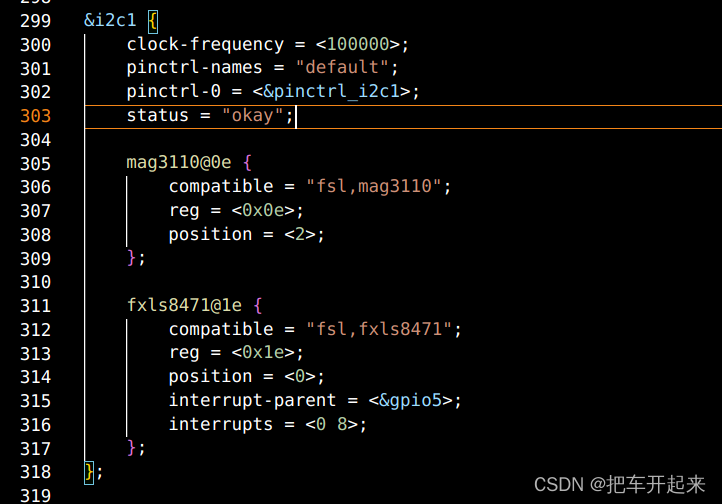
305-316行,NXP 官方的 EVK 开发板上接了 mag3110和fxls8471,这里使用的开发板并没有这这两个器件,所以删掉,并添加上我们使用的

300行,clock-frequency 属性为 I2C 频率,这里设置为 100KHz
302行,inctrl-0 属性指定 I2C 所使用的 IO 为上面的pinctrl_i2c1
305行,ap3216c 子节点, @后面的“1e”是 ap3216c 的器件地址
306行,设置 compatible 值为“my,ap3216c”
307行,reg 属性也是设置 ap3216c 器件地址的,因此 reg 设置为 0x1e
3、验证
改完成以后使用“make dtbs”重新编译一下,然后使用新的设备树启动 Linux 内核
/sys/bus/i2c/devices 目录下存放着所有 I2C 设备,如果设备树修改正确的话,会在/sys/bus/i2c/devices 目录下看到一个名为“0-001e”的子目录,如下
“0-001e”就是 ap3216c 的设备目录,“1e”就是 ap3216c 器件地址。进入0-001e 目录,可以看到“name”文件, name 问价就保存着此设备名字,在这里就是“ap3216c”,如下

四、 代码编写
1、makefile
需要的文件如下图左,修改makefile
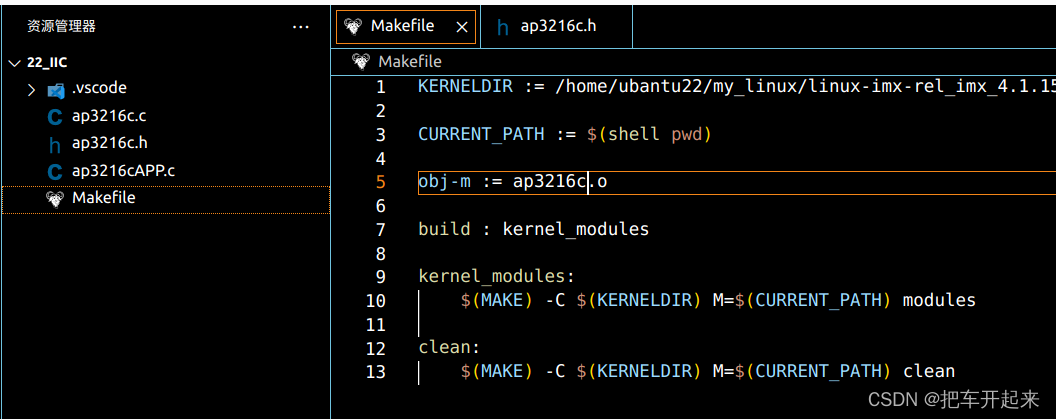
2、ap3216c.h
定义器件及其寄存器地址

3、ap3216c.c
①、头文件

②、驱动出入口
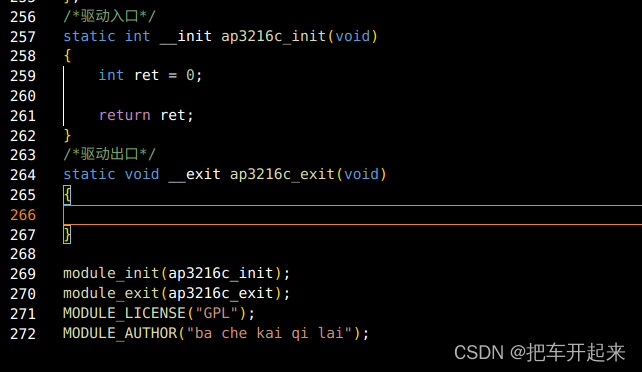
③、 i2c驱动结构体
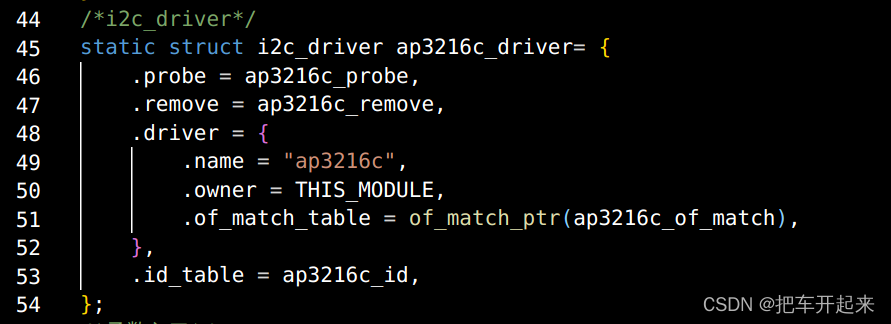
46行,当 I2C 设备和驱动匹配成功以后 probe 函数就会执行,和 platform 驱动一样
47行,当关闭 驱动的时候remove 函数就会执行,和 platform 驱动一样
49行,name是在无设备树时用于和设备进行匹配,也就是上面写的实验,也作为驱动名字;
使用设备树就设置of_match_table变量,也就是驱动的兼容(compatible)属性
53行,id_table 是传统的、未使用设备树的设备匹配 ID 表
④、匹配函数
i2c驱动结构体 里对应的函数

236行,无设备树的时候匹配 ID 表
241行,设备树所使用的匹配表
⑤、probe 函数
在这里面实现基本的字符设备
#define AP3216C_CNT 1
#define AP3216C_NAME "ap3216c"
struct ap3216c_dev{
int devid;
int major;
int minor;
struct cdev cedv;
struct class *class;
struct device *device;
void *private_data;/*私有数据*/
unsigned short ir, als, ps; /* 三个光传感器数据 */
};
static struct ap3216c_dev ap3216cdev;
static int ap3216c_open(struct inode *inode, struct file *filp)
{
return 0;
}
static int ap3216c_release(struct inode *inode, struct file *filp)
{
printk("ap3216c_release\r\n");
return 0;
}
static ssize_t ap3216c_read(struct file *filp, char __user *buf, size_t cnt, loff_t *off)
{
return 0;
}
static struct file_operations ap3216c_fops = {
.owner = THIS_MODULE,
.open = ap3216c_open,
.read = ap3216c_read,
.release = ap3216c_release,
};
static int ap3216c_probe(struct i2c_client *client,const struct i2c_device_id *id)
{
int ret =0;
/*搭建字符设备驱动框架*/
/*1、创建字符设备*/
ap3216cdev.major=0;
if(ap3216cdev.major)
{
ap3216cdev.devid = MKDEV(ap3216cdev.major,0);
ret = register_chrdev_region(ap3216cdev.devid,AP3216C_CNT,AP3216C_NAME);
}else
{
ret = alloc_chrdev_region(&ap3216cdev.devid,0,AP3216C_CNT,AP3216C_NAME);
ap3216cdev.major = MAJOR(ap3216cdev.devid);
ap3216cdev.minor = MINOR(ap3216cdev.devid);
}
if(ret < 0)
{
printk("ap3216cdev_chrdev_region error!\r\n");
goto fail_devid;
}
printk("ap3216cde major: %d minor: %d\r\n",ap3216cdev.major,ap3216cdev.minor);
/*2、注册字符设备*/
ap3216cdev.cedv.owner = THIS_MODULE;
cdev_init(&ap3216cdev.cedv,&ap3216c_fops);
ret = cdev_add(&ap3216cdev.cedv,ap3216cdev.devid,AP3216C_CNT);
if(ret < 0)
{
printk("cdev_add error!\r\n");
goto fail_cdev;
}
/*3、自动创建设备节点*/
ap3216cdev.class = class_create(THIS_MODULE,AP3216C_NAME);
if(IS_ERR(ap3216cdev.class))
{
ret = PTR_ERR(ap3216cdev.class);
goto fail_class;
}
ap3216cdev.device = device_create(ap3216cdev.class, NULL,
ap3216cdev.devid, NULL,AP3216C_NAME);
if(IS_ERR(ap3216cdev.device))
{
ret = PTR_ERR(ap3216cdev.device);
goto fail_device;
}
printk("ap3216c_probe\r\n");
ap3216cdev.private_data = client;
return 0;
fail_device:
class_destroy(ap3216cdev.class);
fail_class:
cdev_del(&ap3216cdev.cedv);
fail_cdev:
unregister_chrdev_region(ap3216cdev.devid,AP3216C_CNT);
fail_devid:
return ret;
}
" return 0 "前一行,将此函数的第一 个参数 client 传递给 ap3216cdev 的 private_data 成员变量
当设备和驱动匹配成功后,probe函数执行,传递的第一个参数就是i2c_client ,i2c_client 每检测到一个 I2C 设备就会给这个 I2C 设备分配一个i2c_client,这里用 ap3216cdev结构体中的private_data 成员接收
⑥、remove 函数

⑦、函数入口出口添加注册i2c_drive

50行,调用 i2c_add_driver 来向 Linux 内 核注册 i2c_driver,也就是 ap3216c_driver
i2c_add_driver 是一个宏,定义如下:
#define i2c_add_driver(driver) \
i2c_register_driver(THIS_MODULE, driver)
i2c_add_driver 就是对 i2c_register_driver 做了一个简单的封装,只有一个参数,就是要注册的 i2c_driver。
66行,调用 i2c_del_driver 来注销掉前面 注册的 ap3216c_driver,函数原型如下:
void i2c_del_driver(struct i2c_driver *driver)
driver:要注销的 i2c_driver。返回值: 无。
⑧、读取AP3216C的N个寄存器
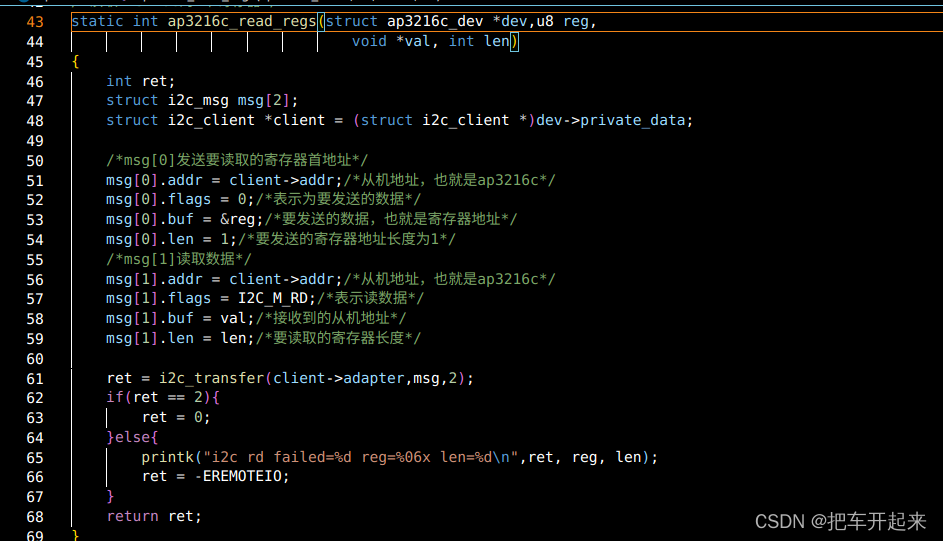
这里先看61行,一般需要在 probe 函数里面初始化 I2C 设备,要初始化 I2C 设备就必须能够对 I2C 设备寄存器进行读写操作,这里就要用到 i2c_transfer 函数了,i2c_transfer 函数最终会调用 I2C 适配器中 i2c_algorithm 里面的 master_xfer 函数,对于 I.MX6U 而言就是i2c_imx_xfer 这个函数。 i2c_transfer 函数原型如下:
int i2c_transfer(struct i2c_adapter *adap,
struct i2c_msg *msgs,
int num)
adap: 所使用的 I2C 适配器, i2c_client 会保存其对应的 i2c_adapter。
msgs: I2C 要发送的一个或多个消息。
num: 消息数量,也就是 msgs 的数量。
返回值: 负值,失败,其他非负值,发送的 msgs 数量
从上面介绍i2c_client结构体就能看到有adapter成员,在probe函数里面已经获取到ap3216cdev设备的private_data成员中
48行,就是把private_data成员中把私有数据提出来,就在61行第一个参数中使用i2c_client中的adapter成员
继续看 i2c_transfer 函数msgs 这个参数,这是一个 i2c_msg 类型的指针参数, I2C 进行数据收发
说白了就是消息的传递, Linux 内核使用 i2c_msg 结构体来描述一个消息。 i2c_msg 结构体定义
在 include/uapi/linux/i2c.h 文件中

69行,从机地址
70行,标志
72行,read data,读数据
79行,要发送消息(本 msg)长度
80行,发送消息的数据
47行,定义结构体数组,按照I2C读时序把操作分为两部分

前面两段作为一部分,就是50-54行;后面两段作另一部分,就是56-59行
50-54行,发送器件寄存器地址。从i2c_client中获取从机地址,标志为0,表示发送数据,要发送的数据,也就是器件寄存器地址,寄存器地址长度为1个字节
56-59行,读取数据。从i2c_client中获取从机地址,标志表示读数据,读出来的数据保存在val,最后为读取的长度
再回到61行,第二个参数就是结构体数组msg,第三个参数就是2,结构体数组msg的长度
⑨、向AP3216C的N个寄存器写数据

76行,这里根据I2C写时序,寄存器地址和数据一次可以发完,所以只需要一个msg即可

79行,寄存器地址保存在b[0],先发寄存器地址
80行,把要发送的数据拷贝到b数组里面
⑩、读、写AP3216C一个寄存器

就是调用函数
⑩①、读取AP3216C的数据
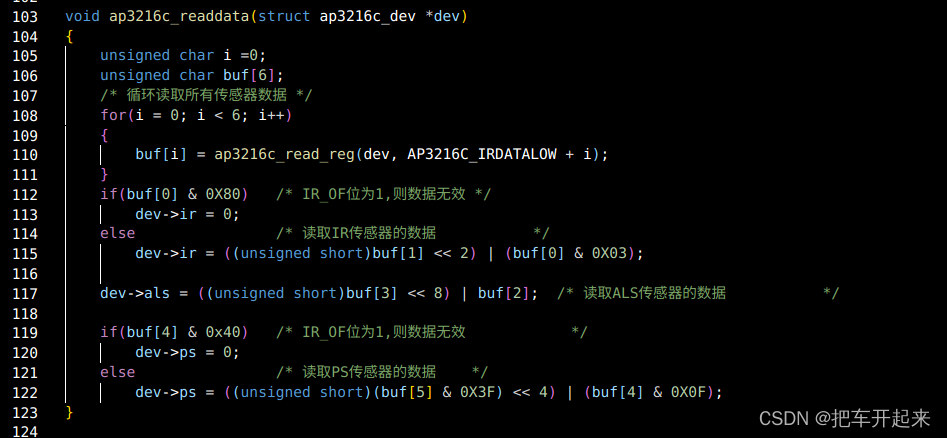
⑩②完善ap3216c_open、read函数
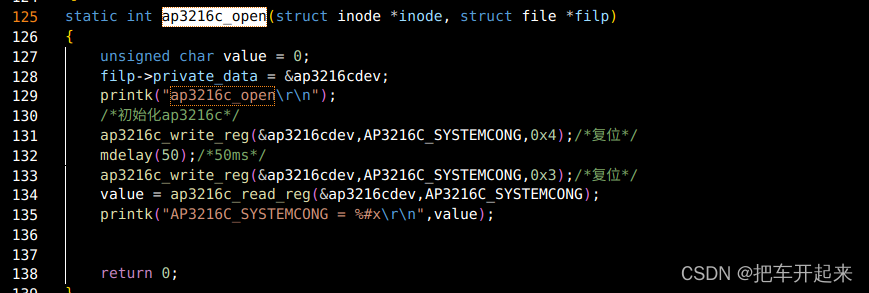

代码如下
#include <linux/module.h>
#include <linux/kernel.h>
#include <linux/init.h>
#include <linux/fs.h>
#include <linux/uaccess.h>
#include <linux/io.h>
#include <linux/cdev.h>
#include <linux/device.h>
#include <linux/of.h>
#include <linux/of_address.h>
#include <linux/of_irq.h>
#include <linux/slab.h>
#include <linux/of_address.h>
#include <linux/of_gpio.h>
#include <linux/atomic.h>
#include <linux/timer.h>
#include <linux/jiffies.h>
#include <linux/string.h>
#include <linux/irq.h>
#include <linux/interrupt.h>
#include <linux/input.h>
#include <linux/i2c.h>
#include <linux/delay.h>
#include "ap3216c.h"
#define AP3216C_CNT 1
#define AP3216C_NAME "ap3216c"
struct ap3216c_dev{
int devid;/* 设备号 */
int major;
int minor;
struct cdev cedv;/* cdev */
struct class *class;/* 类 */
struct device *device;/* 设备 */
void *private_data;/*私有数据*/
unsigned short ir, als, ps; /* 三个光传感器数据 */
};
static struct ap3216c_dev ap3216cdev;
/*读取AP3216C的N个寄存器*/
static int ap3216c_read_regs(struct ap3216c_dev *dev,u8 reg,
void *val, int len)
{
int ret;
struct i2c_msg msg[2];
struct i2c_client *client = (struct i2c_client *)dev->private_data;
/*msg[0]发送要读取的寄存器首地址*/
msg[0].addr = client->addr;/*从机地址,也就是ap3216c*/
msg[0].flags = 0;/* 标记为发送数据 */
msg[0].buf = ®/*要发送的数据,也就是寄存器地址*/
msg[0].len = 1;/*要发送的寄存器地址长度为1*/
/*msg[1]读取数据*/
msg[1].addr = client->addr;/*从机地址,也就是ap3216c*/
msg[1].flags = I2C_M_RD;/*表示读数据*/
msg[1].buf = val;/*接收到的从机地址*/
msg[1].len = len;/*要读取的寄存器数据长度*/
ret = i2c_transfer(client->adapter,msg,2);
if(ret == 2){
ret = 0;
}else{
printk("i2c rd failed=%d reg=%06x len=%d\n",ret, reg, len);
ret = -EREMOTEIO;
}
return ret;
}
/*向AP3216C的N个寄存器写数据*/
static int ap3216c_write_regs(struct ap3216c_dev *dev,u8 reg,
u8 *buf , u8 len)
{
u8 b[256];
struct i2c_msg msg;
struct i2c_client *client = (struct i2c_client *)dev->private_data;
/*构建要发送的数据,也就是寄存器首地址+实际的数据*/
b[0] = reg;/*msg[0]发送要读取的寄存器首地址*/
memcpy(&b[1], buf, len);
msg.addr = client->addr;/*从机地址,也就是ap3216c*/
msg.flags = 0;/*表示为要发送的数据*/
msg.buf = b;/*要发送的数据,寄存器首地址+实际的数据*/
msg.len = len +1;/*要发送的数据长度:寄存器首地址+实际的数据*/
return i2c_transfer(client->adapter,&msg,1);
}
/*读取AP3216C一个寄存器*/
static unsigned char ap3216c_read_reg(struct ap3216c_dev *dev,u8 reg)
{
u8 data=0;
ap3216c_read_regs(dev,reg,&data,1);
return data;
}
/*向AP3216C一个寄存器写数据*/
static void ap3216c_write_reg(struct ap3216c_dev *dev, u8 reg , u8 data)
{
u8 buf = data;
ap3216c_write_regs(dev,reg,&buf,1);
}
void ap3216c_readdata(struct ap3216c_dev *dev)
{
unsigned char i =0;
unsigned char buf[6];
/* 循环读取所有传感器数据 */
for(i = 0; i < 6; i++)
{
buf[i] = ap3216c_read_reg(dev, AP3216C_IRDATALOW + i);
}
if(buf[0] & 0X80) /* IR_OF位为1,则数据无效 */
dev->ir = 0;
else /* 读取IR传感器的数据 */
dev->ir = ((unsigned short)buf[1] << 2) | (buf[0] & 0X03);
dev->als = ((unsigned short)buf[3] << 8) | buf[2]; /* 读取ALS传感器的数据 */
if(buf[4] & 0x40) /* IR_OF位为1,则数据无效 */
dev->ps = 0;
else /* 读取PS传感器的数据 */
dev->ps = ((unsigned short)(buf[5] & 0X3F) << 4) | (buf[4] & 0X0F);
}
static int ap3216c_open(struct inode *inode, struct file *filp)
{
unsigned char value = 0;
filp->private_data = &ap3216cdev;
printk("ap3216c_open\r\n");
/*初始化ap3216c*/
ap3216c_write_reg(&ap3216cdev,AP3216C_SYSTEMCONG,0x4);/*复位*/
mdelay(50);/*50ms*/
ap3216c_write_reg(&ap3216cdev,AP3216C_SYSTEMCONG,0x3);/*复位*/
value = ap3216c_read_reg(&ap3216cdev,AP3216C_SYSTEMCONG);
printk("AP3216C_SYSTEMCONG = %#x\r\n",value);
return 0;
}
static int ap3216c_release(struct inode *inode, struct file *filp)
{
printk("ap3216c_release\r\n");
return 0;
}
static ssize_t ap3216c_read(struct file *filp, char __user *buf, size_t cnt, loff_t *off)
{
long err=0;
short data[3];
struct ap3216c_dev *dev = (struct ap3216c_dev *)filp->private_data;
/*向应用返回AP3216C的原始数据*/
ap3216c_readdata(dev);
data[0] =dev->ir;
data[1] =dev->als;
data[2] =dev->ps;
err = copy_to_user(buf, data,sizeof(data));
return 0;
}
static struct file_operations ap3216c_fops = {
.owner = THIS_MODULE,
.open = ap3216c_open,
.read = ap3216c_read,
.release = ap3216c_release,
};
static int ap3216c_probe(struct i2c_client *client,const struct i2c_device_id *id)
{
int ret =0;
/*搭建字符设备驱动框架*/
/*1、创建字符设备*/
ap3216cdev.major=0;
if(ap3216cdev.major)
{
ap3216cdev.devid = MKDEV(ap3216cdev.major,0);
ret = register_chrdev_region(ap3216cdev.devid,AP3216C_CNT,AP3216C_NAME);
}else
{
ret = alloc_chrdev_region(&ap3216cdev.devid,0,AP3216C_CNT,AP3216C_NAME);
ap3216cdev.major = MAJOR(ap3216cdev.devid);
ap3216cdev.minor = MINOR(ap3216cdev.devid);
}
if(ret < 0)
{
printk("ap3216cdev_chrdev_region error!\r\n");
goto fail_devid;
}
printk("ap3216cde major: %d minor: %d\r\n",ap3216cdev.major,ap3216cdev.minor);
/*2、注册字符设备*/
ap3216cdev.cedv.owner = THIS_MODULE;
cdev_init(&ap3216cdev.cedv,&ap3216c_fops);
ret = cdev_add(&ap3216cdev.cedv,ap3216cdev.devid,AP3216C_CNT);
if(ret < 0)
{
printk("cdev_add error!\r\n");
goto fail_cdev;
}
/*3、自动创建设备节点*/
ap3216cdev.class = class_create(THIS_MODULE,AP3216C_NAME);
if(IS_ERR(ap3216cdev.class))
{
ret = PTR_ERR(ap3216cdev.class);
goto fail_class;
}
ap3216cdev.device = device_create(ap3216cdev.class, NULL,
ap3216cdev.devid, NULL,AP3216C_NAME);
if(IS_ERR(ap3216cdev.device))
{
ret = PTR_ERR(ap3216cdev.device);
goto fail_device;
}
printk("ap3216c_probe\r\n");
ap3216cdev.private_data = client;
return 0;
fail_device:
class_destroy(ap3216cdev.class);
fail_class:
cdev_del(&ap3216cdev.cedv);
fail_cdev:
unregister_chrdev_region(ap3216cdev.devid,AP3216C_CNT);
fail_devid:
return ret;
}
static int ap3216c_remove(struct i2c_client *client)
{
cdev_del(&ap3216cdev.cedv);
unregister_chrdev_region(ap3216cdev.devid,AP3216C_CNT);
device_destroy(ap3216cdev.class, ap3216cdev.devid);
class_destroy(ap3216cdev.class);
printk("ap3216c_remove\r\n");
return 0;
}
/*传统匹配表*/
static struct i2c_device_id ap3216c_id[] = {
{"my,ap3216c",0},
{}
};
/*设备树匹配*/
static struct of_device_id ap3216c_of_match[] = {
{.compatible = "my,ap3216c"},
{}
};
/*i2c_driver*/
static struct i2c_driver ap3216c_driver= {
.probe = ap3216c_probe,
.remove = ap3216c_remove,
.driver = {
.name = "ap3216c",
.owner = THIS_MODULE,
.of_match_table = of_match_ptr(ap3216c_of_match),
},
.id_table = ap3216c_id,
};
/*驱动入口*/
static int __init ap3216c_init(void)
{
int ret = 0;
/*添加*/
ret = i2c_add_driver(&ap3216c_driver);
return ret;
}
/*驱动出口*/
static void __exit ap3216c_exit(void)
{
i2c_del_driver(&ap3216c_driver);
}
module_init(ap3216c_init);
module_exit(ap3216c_exit);
MODULE_LICENSE("GPL");
MODULE_AUTHOR("ba che kai qi lai");4、ap3216c.c
#include <sys/types.h>
#include <sys/stat.h>
#include <fcntl.h>
#include <stdio.h>
#include <unistd.h>
#include <stdlib.h>
#include <string.h>
#include <sys/ioctl.h>
#include <linux/input.h>
/*
argc:应用程序参数个数(argv数组元素个数)
argv:具体参数,也可以写作char **argv
./ap3216cAPP <filename>
./ap3216cAPP /dev/ap3216c
*/
int main(int argc, char *argv[])
{
int fd,err;
char *filename;
unsigned short ir, als, ps, data[3];
/*判断命令行输入参数是否正确*/
if(argc != 2){
printf("error usage!\r\n");
return -1;
}
/*用指针指向文件*/
filename = argv[1];
/*打开文件*/
fd = open(filename , O_RDWR);
if(fd < 0){
printf("file open failed\r\n",filename);
return -1;
}
while(1)
{
err =read(fd,&data,sizeof(data));
if(err == 0)
{
ir=data[0];
als=data[1];
ps=data[2] ;
printf("ap3216c ir = %d,als = %d,ps = %d\r\n",ir,als,ps);
}
usleep(200000);/*200ms*/
}
/*关闭文件*/
close(fd);
return 0;
}用APP测试驱动

用手接近和用灯照ap3216c传感器,数值都会发生变化


